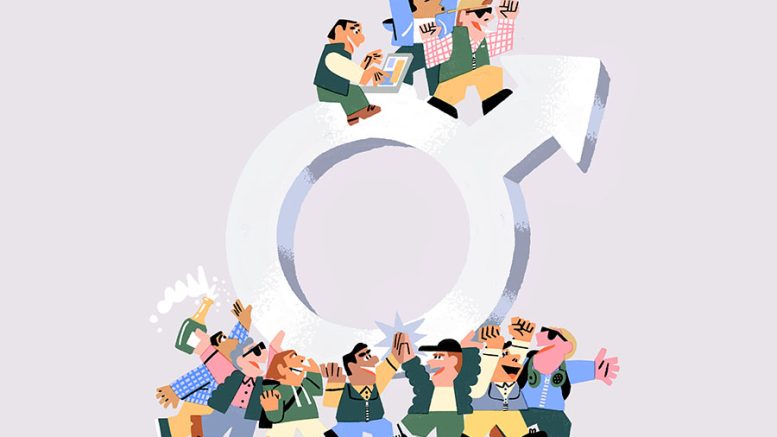Introduction
Due to the early dominance of Silicon Valley by white males, bro-culture gradually formed and has caused a series of bias problems in the technology workplace. Bro-culture has led to the marginalization of women, non-white groups, and individuals inclined towards non-heterosexual norms in the technology workplace. These issues continue to this day and still pose challenges for workplace women and people of color. In recent years, these problems have gradually been taken seriously, and relevant policies have emerged to solve them. Nevertheless, by researching and analyzing recent data related to the technology workplace, these bias issues have not been effectively addressed.

The background of bro-culture
The origin of bro-culture can be traced back to the commune movement in the United States in the 1960s. The new communalists aimed to create a work environment that was not influenced by politics and advocated for de-bureaucracy and abandoning traditional rules (Lusoli & Turner, 2021). Besides, the members of the laboratory during World War II were mainly composed of well-educated white male scientists, and they were mostly middle-class or upper-middle-class. In their process of organizing and building the early internet industry, they included individuals with similar cultures and excluded those without these cultures (Lusoli & Turner, 2021).
Indeed, the early bro-culture pursued anti-bureaucracy and built a technological environment that was as free from political influence as possible. Nevertheless, the de-bureaucracy of bro-culture also invalidates the biases that bureaucracy would have prevented (Lusoli & Turner, 2021). Also, due to its nature of de-bureaucracy, it harbors hostility towards national regulation, making it difficult to regulate.
The bro-culture in Silicon Valley can be seen as a continuation or replay of this dynamic. The main members involved in the early construction of Silicon Valley were a group of white male technical workers, and to this day, leadership in the technology industry in Silicon Valley is still dominated by white males.

The continuity of bro-culture in Silicon Valley and its relate bias issues
Bro-culture in Silicon Valley is an ongoing bromance (Lusoli & Turner, 2021) that can also be classified as an internet culture. Due to the continuity of internet culture, the bias problems brought about by bro-culture continue to marginalize women and non-white groups in the technology industry. In today’s technology workplace, they still face challenges, including but not limited to racial discrimination, gender discrimination, and even sexual harassment.
Although there have been “diversity pledges” in many major technology corporations in Silicon Valley since 2015 to promote diversity and inclusivity and prevent unconscious bias issues in the workplace, relevant research data shows that these policies have less significant effects and have not effectively alleviated the problems faced by women and non-white groups. According to Reveal’s analysis in 2016, ten big technology businesses in Silicon Valley did not employ a black woman. Among those companies that did hire women and non-white groups, this group of employees was overrepresented in support work. Compared to white men who accounted for 39% and 59% of professionals and executives respectively, Asian women accounted for 12% of professionals and 4.5% of executives, and one-third of businesses in Silicon Valley did not have female executives of color. To sum up, for women and colored races, the higher the status, the fewer positions they hold.

Twine (2018) proposed that black females are at a disadvantage in several aspects of the labor market in Silicon Valley. A black female software engineer named Carmen stated that she was asked tricky questions by a white male interviewer during an interview, which had nothing to do with her job skills (Twine, 2018). And another black female employee at Dropbox, Coleman, found it difficult to establish relationships with colleagues of different races, genders, and classes in the workplace, and was warned by a white manager that she was almost impossible to be promoted (Twine, 2018). Furthermore, black women in the technology industry have relatively low salaries, lower than non-black women and men (Twine, 2018). In brief, the identity of women and colored races has led to various inequalities faced by black women, including job applications, workplace relationships, promotions, and salary benefits.
Silicon Valley technology companies’ explanation for the lack of representation of colored employees among their employees was that they did not possess excellent educational certificates and outstanding skills (Twine, 2018). However, the learning environment of science, technology, engineering, and mathematics (STEM) has been proven unwelcoming for ethnic minorities, colored races, women, and individuals with minority sexual orientations (Miller et al., 2021). The study and completion of an undergraduate degree in STEM is a necessary path to the highly paid technology industry, but this learning environment has also been plagued by bro-culture, leading to a widespread culture centered around heterosexual men. In the study of the bro-culture of STEM learning environment (Miller et al., 2021), a transgender, non-bisexual woman, Callie, recounted that the learning environment was rife with anti-LGBTQ phrases and words, such as homosexual men being called “faggot” even though they did not like being called that, and often hearing jokes that were offensive to the LGBTQ community. Another female participant, Marina, shared a phenomenon that when men got together, they usually turned their backs on her and her female friends, describing herself as ignored and ostracized (Miller et al., 2021). These participants’ accounts illustrate the necessity of curbing bro-culture and creating a STEM learning environment that are more friendly to the groups mentioned above.
Besides, DDI’s 2023 global leadership forecast speculates that the proportion of women in technical leadership roles across the entire technology industry would be lower, as many female technology leaders leave their positions because of pressure at work, workplace discrimination, and workplace harassment. For instance, YouTube CEO Susan Wojcicki and Meta CEO Marne Levine both resigned from their respective positions in February 2023. In the future, women may occupy fewer and fewer positions in the leadership of the technology industry.
The significance and difficulty of regulating bro-culture
The bro-culture is so prevalent in the tech workforce that 72% of women in tech reported in TrustRadius’ 2021 Women in Tech Report that they have worked at a company with a bro-culture. However, only 41% of men in this report said the same thing. This cognitive difference indicates that it is difficult for those in power or those who have not been negatively affected to recognize the negative impact of bro-culture and proactively address it. Furthermore, related to the anti-bureaucracy of Silicon Valley’s early creators, today the beneficiaries of bro-culture in Silicon Valley remain indifferent to laws and rules. Hence, although there are already relevant rules to regulate the bias issues brought about by bro-culture, these issues are still difficult to solve.
However, although regulation of the bias issues related to bro-culture faced challenges, it still necessary and significant. Firstly, the prevalence of bro-culture will exacerbate the exclusion of women from the technology industry. Bro-culture is a modern manifestation of patriarchy, and women who do not conform to the biases of bro-culture are often marginalized and excluded in the technology workplace. Moreover, the growing bro-culture has also intensified the tolerance of harmful behaviors such as sexual harassment. Google’s software engineer Lee has accused Google’s bro-culture of causing a series of sexual harassment incidents, including male colleagues drugging her drinks and installing cameras under her desk. Secondly, in recent years, many internet platforms have been accused of algorithmic bias against colored races and women, and a large part of the reasons for these biases can be attributed to the bro-culture of the creative team. Therefore, if bro-culture is not regulated and continues to develop, the internet environment may gradually be eroded by racism and gender discrimination.
Conclusion
In a word, the bro-culture in technology companies has brought a series of biases against women, colored races, and individuals with minority sexual orientations to the technology workplace and related learning environment. The origin of bro-culture can be traced back to the early stages of Silicon Valley construction, and due to its continuity, it continues to have negative impacts on the technology workplace. Hence, it is necessary to address the bias problems brought about by brotherly culture, despite facing difficulties in various aspects.
This work is licensed under a Creative Commons Attribution-NonCommercial-NoDerivatives 4.0 International License.
Bibliography
Cohen, M. (2023). Female leadership in tech is falling. CNBC. https://www.cnbc.com/2023/03/22/female-leadership-in-tech-is-falling.html
Lusoli, A., & Turner, F. (2020). “It’s an Ongoing Bromance”: Counterculture and Cyberculture in Silicon Valley—An Interview with Fred Turner. Journal of Management Inquiry, 30(2), 235-242. https://doi.org/10.1177/1056492620941075
Miller, R. A., Vaccaro, A., Kimball, E. W., & Forester, R. (2021). “It’s dude culture”: Students with minoritized identities of sexuality and/or gender navigating STEM majors. Journal of Diversity in Higher Education, 14(3), 340-352. https://doi.org/10.1037/dhe0000171
Olsen, S. (2023). ‘Bro Culture’ Is Bad for Employees & for Business. Here’s Why These Toxic Environments Are Still So Common. InHerSight.com. https://www.inhersight.com/blog/diversity/bro-culture
Rangarajan, S. (2018). Bay Area tech diversity: White men dominate Silicon Valley. Reveal. https://revealnews.org/article/heres-the-clearest-picture-of-silicon-valleys-diversity-yet/
Twine, F. W. (2018). Technology’s Invisible Women: Black Geek Girls in Silicon Valley and the Failure of Diversity Initiatives. International Journal of Critical Diversity Studies, 1(1), 58. https://doi.org/10.13169/intecritdivestud.1.1.0058



Be the first to comment on "What bias issues does bro-culture bring to the technology workplace, and why do these issues need to be addressed?"